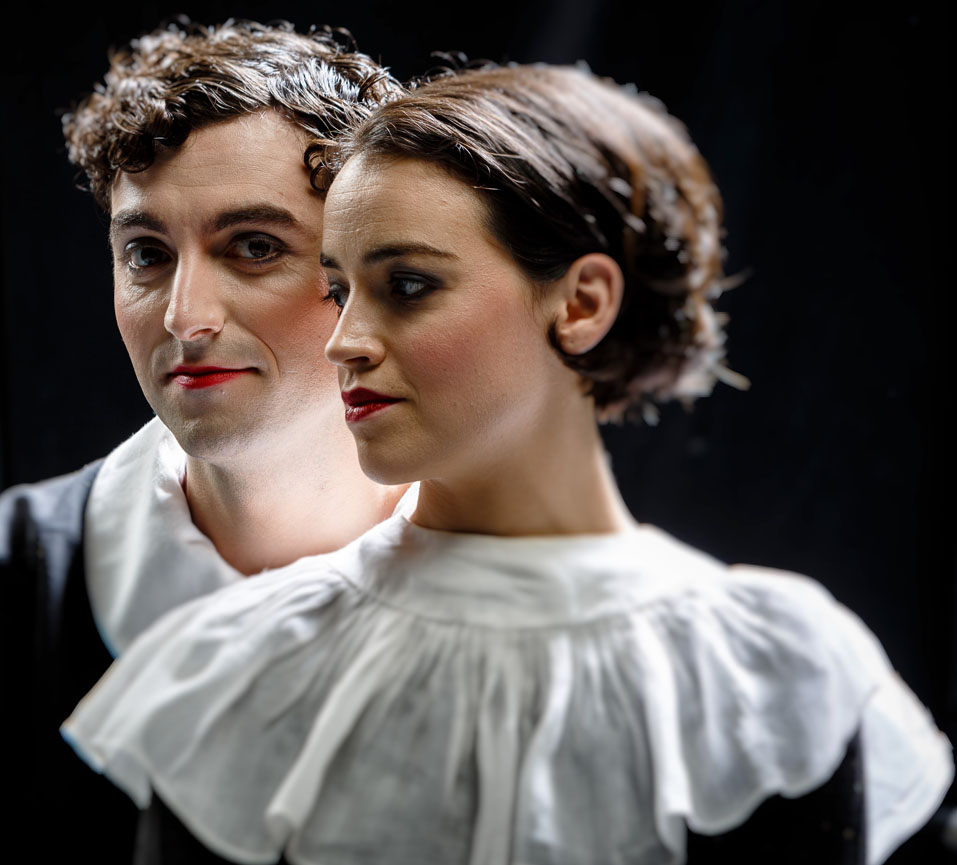
Kneehigh’s The Flying Lovers of Vitebsk is a portrait of Marc Chagall’s and Bella Rosenfeld’s marriage. It is a portrait as colourful, as quirky and as inventive as Chagall’s own paintings, and it has enormous charm. Writer Daniel Jamieson and director Emma Rice created their first version of this story over twenty years ago for Theatre Alibi. This new production marks the end of Rice’s long association with Kneehigh, as she has now moved to become Artistic Director for Shakespeare’s Globe.
Although he is often thought of as a French artist, Chagall was a Russian Jew by birth, and at one time he was a well-regarded avant-garde figure in his homeland, setting up his own academy in his birthplace, the Belarusian town of Vitebsk. Today he is perhaps best known for the series of double portraits he painted of himself and his wife Bella soaring together in flight. These paintings have a joyous dream-like quality; they are marvelous visual expressions of what it is to be in love. But their life together was not all joy and romance. He had welcomed the promise of freedom offered by the revolution of 1918, but the Soviet authorities soon came to believe that he was too much of an individual, forcing him to resign from his own school. ‘Must we all paint the same way?’ he cries, when confronted with the harsh reality of totalitarian control. Eventually the way of life the Chagalls had known in Vitebsk was gone, attacked first by the Communist authorities and then utterly destroyed by the Nazis. By then Marc and Bella had fled Russia, never to return.
The Flying Lovers of Vitebsk is performed on and around a tilted asymmetric platform set within an equally asymmetric structure of large poles, from which are suspended ropes. As with Chagall’s paintings, this set defies conventional norms of scale and perspective. Upstage there is a screen that frequently blazes in bright exotic colours. To the side sit two musicians, composer and music director Ian Ross and James Gow, who play a variety of instruments including piano, cello, accordion and mandolin. Their music is a fully integrated element in the story-telling, featuring idiomatic dance tunes and songs in Yiddish.
The Flying Lovers of Vitebsk is graced with two remarkable central performances. Chagall is played by Marc Antolin, who vividly conveys the young artist’s obsessive need to create. His enthusiasm, optimism and passionate love for his wife are seen as attractive qualities that do not entirely mask his tendency to be more than a little self-absorbed. Audrey Bresson is Bella; bright-eyed, petite and highly intelligent, yet prepared to play second fiddle to her ambitious husband. ‘I want to waste the rest of my life with you’. Bresson is both an actor and a classically trained singer, and as a child and teenager she gained extensive experience with Cirque Du Soleil as a vocalist and acrobat. She employs this impressive range of skills to great effect when Bella first meets and falls in love with Chagall. She moves with extraordinary fluidity in a kind of eccentric pas de deux with Antolin in a scene that is suffused with gentle humour and passion. Their wedding celebrations involve a gloriously surreal dance, with Bella and Marc appearing to be sat on chairs that fly energetically around the room.
The Flying Lovers of Vitebsk is at its best when the focus is on Marc and Bella’s individual personalities and their passion for each other. Some of the complexities of their married life are rather briefly glossed over, and there is perhaps at times a little too much use of expository passages to delineate major events in their lives, including their eventual escape from Vichy France in 1941, fleeing to the USA via Lisbon. During the Second World War Bella began to express her own creativity, writing a memoire of her childhood in Vitebsk. Tragically she died in 1944, aged only 56, and it was only then that Chagall came to see that she had been more than just his inspiration and his soulmate, belatedly recognizing that she had been an artist in her own right. He was devastated by her death and was unable to work for months afterwards, but The Flying Lovers of Vitebsk does not end on such a sombre note. Very much in the spirit of Chagall’s paintings, that so often convey a poignant mix of gaiety and sadness, we see Bella return to him as an angelic muse, and he is reinvigorated. Typically of the kind of work we have come to expect from Kneehigh, The Flying Lovers of Vitebsk is an enchanting piece of pure theatre, a glorious celebration of a great artist and of a uniquely creative relationship. ★★★★☆ Mike Whitton 3rd June 2016
Photo – Steve Tanner

